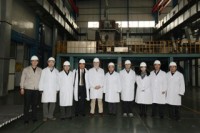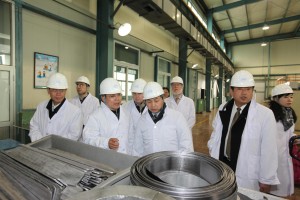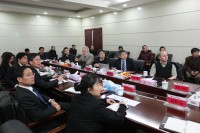On 18 February 2011, a delegation of Global Design Effort representatives visited the Orient Tantalum Industry Co. Ltd (OTIC), Ningxia, a leading niobium company in China. The group consisted of ILC project managers Akira Yamamoto and Marc Ross, together with Robert Rimmer of Thomas Jefferson Laboratory in the US, accompanied by Asian Linear Collider Steering Committee Chairman Jie Gao and ILC group member Jiyuan Zhai of the Institute of High Energy Physics (IHEP) in Beijing.
With the aim of preparing for ILC superconducting radiofrequency (SCRF) cavity and cryomodule industrialisation, and to seek cost-effective mass-production scenarios for the SCRF cavity and cryomodule systems, the ILC project managers set up a plan for industrial communication. They decided to pay visits to twelve companies between early February and late April 2011 to discuss technical specifications and industrial models. The companies, based in America, Asia and Europe, are manufacturers of niobium material or cavities and cryomodules.

Visitors and OTIC managers stand in front of a 600-kilowatt electron beam furnace, which is used for electron beam melting. Image: OTIC
OTIC, located in the Ningxia Hui autonomous region of China, is the last company in Asia that ILC project managers visited. “As a very close collaborator with IHEP (see 22 July 2010 and 2 September 2010) and with Peking University (see 9 September 2010) on superconducting technology for many years, OTIC is one of the most important niobium production companies in Asia,” said Gao. OTIC, established in April 1999, is a controlled subsidiary company under China Nonferrous Metal Ningxia Orient Group Co., Ltd (CNMNC). Due to a combination of core prime assets and achievements in scientific research contributed by CNMNC as the main originator, OTIC is a large sized enterprise specialising in scientific research, development and production of rare metals, is the biggest manufacturer of tantalum and niobium in China and is one of the world’s three top tantalum processors. It is also the only Asian member of the executive committee of Tantalum-Niobium International Study Center. OTIC is an important supply base for new materials of such rare metals as tantalum, niobium and beryllium for high-tech applications and an export-oriented high-tech enterprise in China. “I have been much impressed with the promising configuration and scale of the company, which has a highly motivated spirit for advanced technology,” said Yamamoto.
OTIC contains all fabrication plants of niobium sheets including pressing, out-gassing and sintering, electron beam welding, cutting, forging, mechanical grinding, rolling, polishing, cutting and annealing. “We learned a lot about this company and enjoyed very much the tour of very active factories and laboratories of OTIC,” said Yamamoto after the guided visit tour of fabrication plants of OTIC. The detailed discussions between ILC project managers and OTIC experts established a mutual understanding both on ILC requirements and OTIC capacity and its future planning. “It would be nicest for me to understand that OTIC may cover most of our technical requirement of niobium material as well as niobium-titanium alloy production,” said Yamamoto.
As a forward-looking action, a new sub-company dedicated to superconducting materials and components supply called Ningxia Orient Superconductor Technology Co., Ltd., run jointly by OTIC and Peking University, is to be established on 28 February. “It shall be a unique feature of OTIC to be realised soon, and it will open a new door for the company. It will handle everything, including all processes from materials to cavity integration,” said Yamamoto. “I hope to extend our cooperation, especially with a company that demonstrates a pioneering spirit for advancing superconductivity technologies.”
In early March, ILC project managers will extend their industrial communication to companies in Europe. Stay tuned for more news from the industry world.



Recent Comments